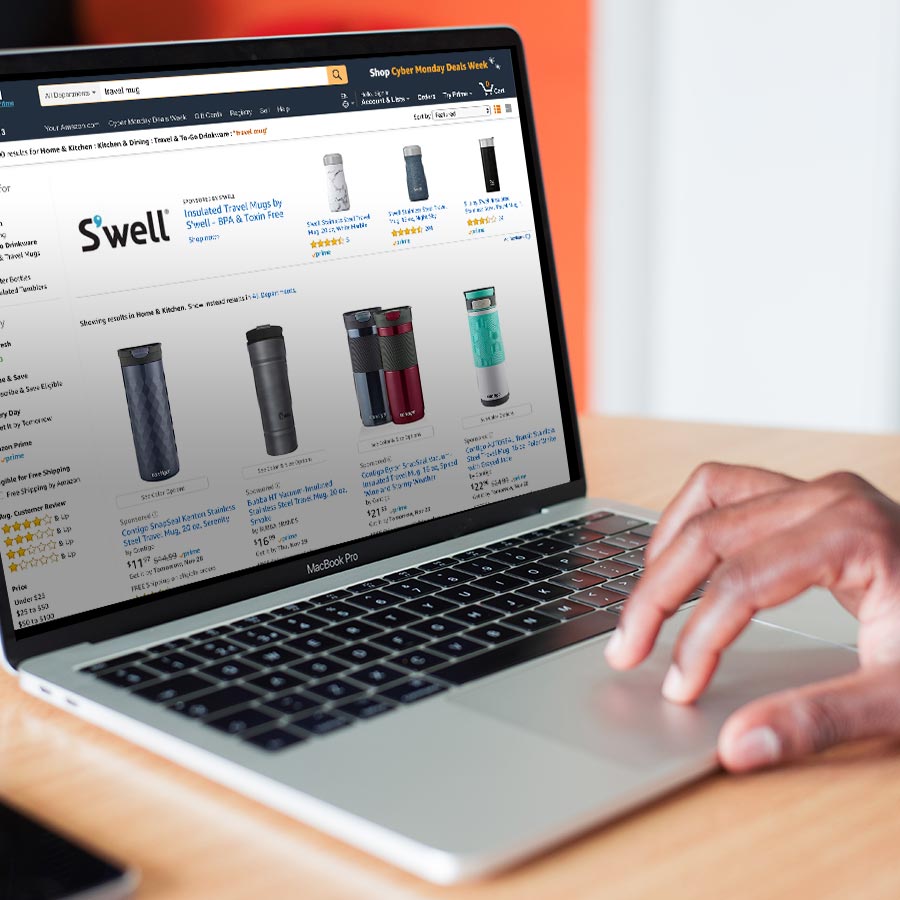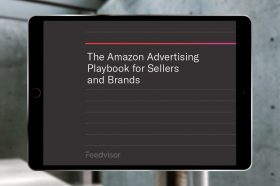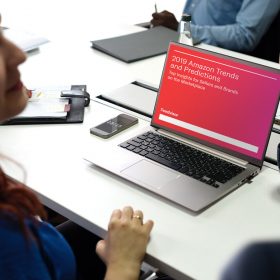Resources - Blog
5 Optimization Tips for Sponsored Brands

Stay on top of the latest e-commerce and marketplace trends.
Formerly known as Headline Search Ads, Sponsored Brands are the Amazon pay-per-click campaigns that appear in the prime location above Sponsored Products and organic search results. The ads are keyword-targeted and feature customizable copy, a brand logo, and three spaces to showcase individual products within the creative. When a shopper clicks on a specific product’s image or copy within the ad, they are taken to the product detail page, whereas when they click on the logo, headline copy, or “Shop Now” button, they are brought to a listing of the product included in the campaign.
Given the highly sought-after location of Sponsored Brands, they are frequently utilized to drive sales and increase brand visibility. As middle-of-the-funnel ads, they might lead to more loyal, repeat buyers. We have compiled five actionable tips to maximize the impact of your Sponsored Brands campaigns.
1. Research Keyword Traffic Volume.
Sponsored Brands can have a variety of keywords on all three match types, with bids based on anticipated impact. Sponsored Products and Brands use an auction-based pricing model, so you need to bid competitively in order to win the high-traffic keywords. High-traffic, high-impact keywords should have higher bids, while broader keywords should be assigned lower bids. When you enter keywords for your Sponsored Brands campaign, you will be shown a list of suggested keywords. Next to each keyword is an indicator of how much traffic it receives — high, medium, or low — based on expected number of impressions and the relevance of the ASINs you are including.
2. Create a Plan for Your Ad Spend.
During the first few weeks of Q1, set aside time to evaluate your ad performance from the previous year to identify where you excelled and where gaps exist that you can work to fill with campaigns. Was your performance up to par with competitive items in your product categories? Are you taking advantage of the various ad types available to you, whether you are a 1P, 3P, or hybrid seller, to drive traffic to your listings?
Creating a detailed plan for your ad spend to refer back to throughout the year will help you effectively track the impact that advertising is having on your bottom line. If your budget is imposing limits on your bids, you may not win impressions on high-traffic keywords. Low-traffic keywords will have less bid competition, making it easier for you to win the auction. Always keep the shopper front of mind and work to tailor your products to their potential searches.
3. From There, Identify the Right Keywords That Align With Your Budget.
Incorporate a strategic variety of keywords to increase the chances of your ads being shown. Include branded product keywords, such as your brand and product name and a few variations. You can also include competitor-branded keywords. Given that both of these are real examples of brands and product titles, they are examples of exact match keywords. With these keywords, the customer’s search term needs to exactly match the keyword for the ad to appear. Although it is the most restrictive match type, it is usually more relevant to the buyer’s search. You may also decide to include keywords that don’t exactly match the category of your product, but can help drive buyers to your products from related searches.
4. Run Campaigns Year-Round.
You do not need to wait for Prime Day, Black Friday, or Cyber Monday to run campaigns and experiment with different ad types. You can test which traditional Amazon advertising opportunities — Sponsored Brands, Sponsored Products, Product Display Ads, and Amazon Stores — work best for your business. You can also try out various non-traditional advertising methods such as A+ Content or external traffic drivers such as email distribution or social media. Running campaigns throughout the year will help you drive brand awareness, increase discoverability, and constantly sharpen your target demographic.
5. Always Experiment to See What Works Best for Your Individual Business Profile.
Cast a wide net when creating your initial keyword list, to ensure that you aren’t leaving out any potential strong performers. When you limit your keyword set from the start, you will have less information to learn from — experimentation is vital when it comes to consistently improving your keyword research and structure. Keywords with low performance can easily be paused or bid down, so feel free to be creative in your keyword research.
However, you do want to make sure that your keywords are relevant, as there is a limit of 1,000 keywords per ad group with Sponsored Brands and manual Sponsored Products campaigns. With all keywords involved in your Amazon detail pages and ad campaigns, there should be an emphasis on tailoring them for visibility, relevance, and conversion. With Sponsored Brands specifically, you can also test different aspects of the campaign itself, mixing in different custom headlines and images, the mix of ASINs included in the ad and how they are ordered, and the layout and content in your custom landing pages. When A/B testing various aspects of your Sponsored Brands, be sure to change only one variable at a time and run each test for at least two weeks to ensure valid results.
Final Thoughts
With Sponsored Brands, you can drive traffic from the ad to your Amazon branded page — such as Enhanced Brand Content, A+ Content, or your Amazon Store — or to top selling items or a custom URL on Amazon. Be strategic with your keyword choices in order to create a frictionless experience for shoppers, leading them to the most relevant products based on their search queries. It is also worth noting that Sponsored Brands display differently depending on placement and device type.
For example, on mobile, Sponsored Brands only display one picture, so you need to decide whether you want that to display your brand logo or one of your products. The above-the-fold real estate that Sponsored Brands campaigns occupy make them immensely popular amongst brands and retailers operating on the marketplace, so if you have not experimented with them as part of your Amazon advertising strategy, now is the time.
Learn what Feedvisor can do for your business.
When you partner with Feedvisor, you automatically receive access to our true, AI-driven technology and hands-on team of e-commerce experts. Contact one of our team members today to learn more about our end-to-end solution for brands and large sellers on Amazon, Walmart, and e-marketplaces.
![What You Need to Know About MAP Compliance on Amazon [Guide]](https://feedvisor.com/wp-content/uploads/2018/11/What-You-Need-to-Know-About-MAP-Compliance-on-Amazon-blog-280x186.jpg)


